Until farms can control management of gilts for at least 60-plus days before breeding, your gilts will under-perform their genetic potential.
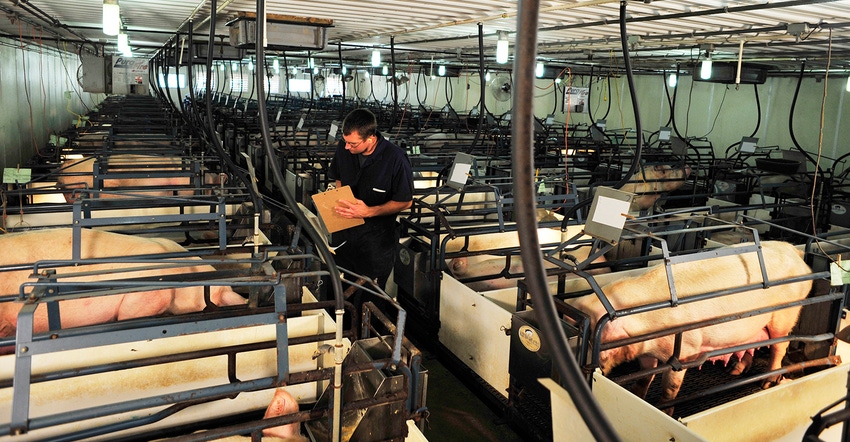
Last month we looked backwards, now it is time to look at what we need to do going forward to make your farm most productive as possible.
The book "The Goal" by Eliyahu M. Goldratt had a big impact on how I look at what I need to work on today, tomorrow, next week, next month and next year. I have these three questions hanging on the wall right over the top of my computer monitor.
What to change?
What to change to?
How to cause the change?
You should be asking yourself these three questions every day.
The genetic companies have a done a great job on improving the potential to produce more pigs and more-efficient pigs. Are you getting the most out of your genetics? We are going to look at total born this month. Chart 1 looks at the total born per female farrowed for the last 15 years. The average has gone from 11.6 in 2015 to 14.9 in 2020, a 3.3 pig improvement, or 28% improvement. The top 10% have gone from 12.4 in 2015 to 15.9 in 2020, a 3.5 pig improvement, or 28.2% improvement.
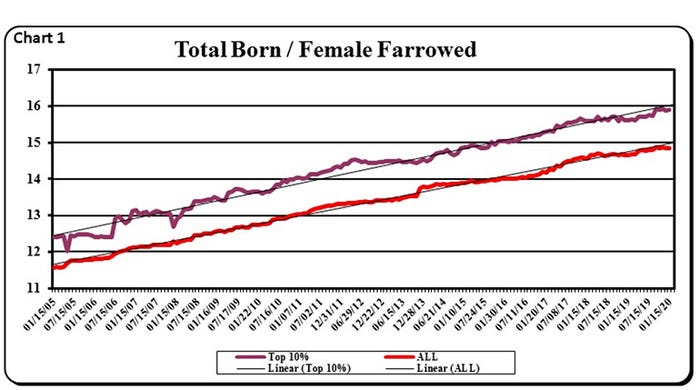
Looking at the just the last three years, Chart 2, and breaking it down by the Top 0-10%, 10-30%, 30-50%, 50-70% and the 70-100% for the whole Swine Management Services Farm Benchmarking database which is 800-plus sow farms and 1.5 million-plus females. The least amount of improvement was in the 10-30% at 2.56% and the most improvement was in the 30-50% at 3.67%.
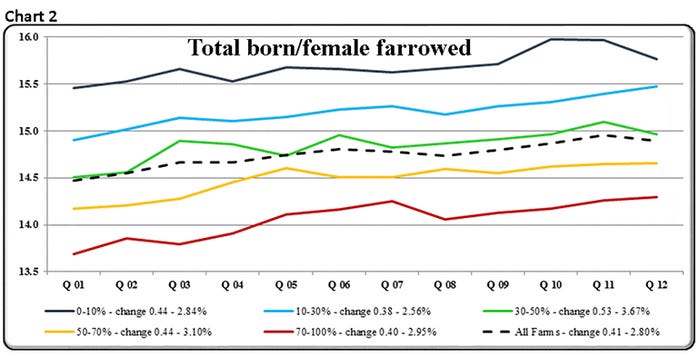
For this column we picked 407 farms from the United States and Canada, which were over 25 pigs weaned per mated female per year. There are 763,804 mated females for an average farm size of 1,877. First, we looked at does farm size have any relationship to total born per female farrowed, and the short answer is no. The average is 15.31 and the range from 14.91 to 15.53, except for the four largest farms that average 16.58 or 1.27 pigs more than the average.
What are these farms doing different? SMS consults with these four farms and the owners are constantly asking "What to change?" and "What to change to?" They are also not afraid to run trials on new ideas on their farms and implement the new ideas that work on their farms.

One comment we always hear is "farms with high total born just have more pigs dying." Table 2 looks at ranking the farms by pigs weaned per mated female per year. There is a direct relationship between total born per female farrowed and pigs weaned per mated female per year. The farms at 25 pigs weaned per mated female per year had a total born of 14.73 and the farms at 34 pigs weaned per mated female per year had a total born of 16.51. Another old saying is "you cannot wean a pig that is not born." The highest-producing farms on pigs weaned per mated female per year have learned how to keep the pigs alive as shown by the average piglet survival. Again, there is a direct relationship from the farms at 25 pigs weaned per mated female per year at 76.1% and the farms at 34 pigs weaned per mated female per year at 84.1%.
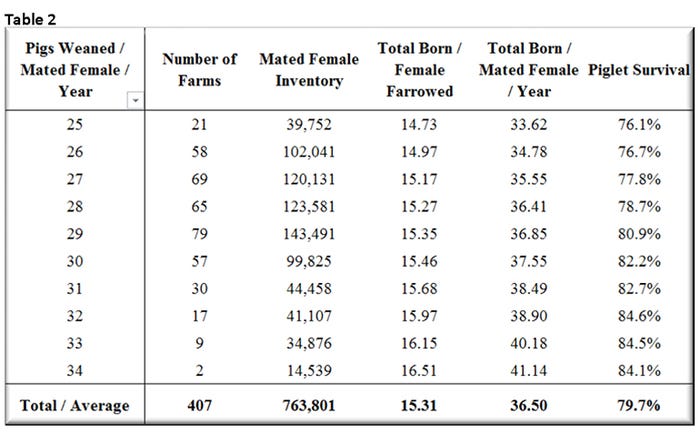
The higher total born starts with Parity 1 (gilt farrowings) as shown in Table 3. There is a direct relationship between pigs weaned per mated female per year and Parity 1 total born. The farms at 25 pigs weaned per mated female per year are at 13.62 total born and the farms at 34 pigs weaned per mated female per year are at 15.05 total born.
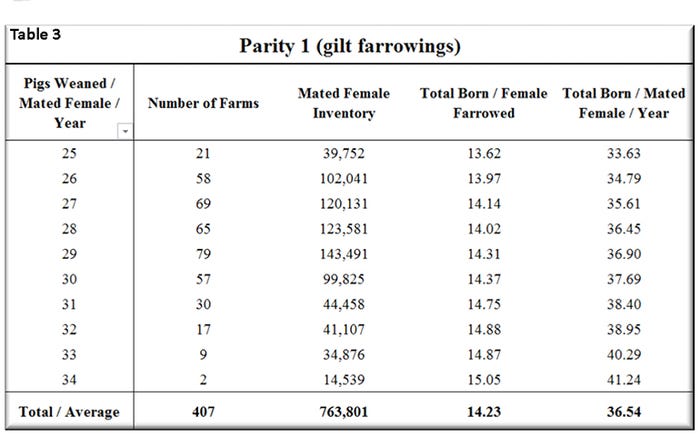
What are the farms with higher total born doing to get those extra pigs? Most have invested money and labor by building and staffing a gilt development unit close to or on-site of the farm. They take over managing replacement gilts as early as an isowean pig for feeder pig. They make sure they are fed as a replacement gilt and not as a finisher pig. When gilts meet a set age the gilts get daily boar exposure, with heat cycle recorded and are usually placed in a gestation crate for 10-plus days for crate exposure before breeding.
Until farms can control management of gilts for at least 60-plus days before breeding, your gilts will underperform their genetic potential. What is your farm doing for gilt development?
Through our SMS Farm Analysis program and consulting, we try to answer the first two questions. How to cause the change will be up to the farm management and staff. The Top 10% have adapted and changed to handle the larger total born and are weaning a higher percent of the pigs in 2020 than they were in 2005.
Table 4 provides the 52-week rolling averages for 11 production numbers represented in the SMS Production Index. The numbers are separated by 90-100%, 70-90%, 50-70%, 30-50% and zero to 30% groups. We also included the 13-week, 26-week and 12-quarter averages. These numbers represent what we feel are the key production numbers to look at to evaluate the farms' performance.
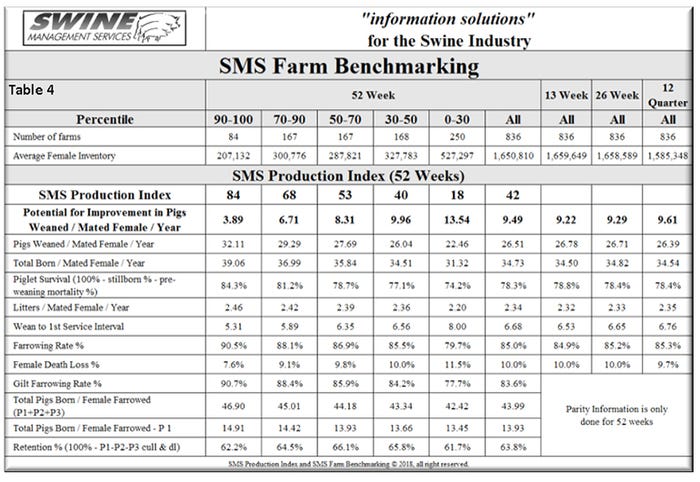
At SMS, our mission statement is to provide "Information solutions for the swine industry." We feel with the creation of different SMS Benchmarking databases for all production areas we now have more detailed information to share with the swine industry. If your farm would like to be part of the SMS Benchmarking databases, or if you have suggestions on production areas to write columns about, contact Mark Rix or Ron Ketchem. We enjoy being a part of the NHF Daily team. Previous columns can be found at NationalHogFarmer.com.
Sources: Ron Ketchem and Mark Rix, who are solely responsible for the information provided, and wholly own the information. Informa Business Media and all its subsidiaries are not responsible for any of the content contained in this information asset.
About the Author(s)
You May Also Like


